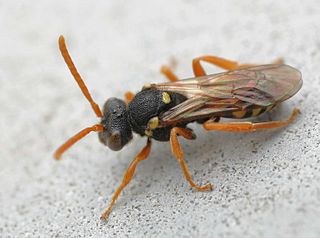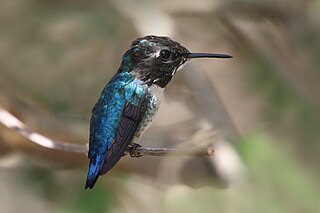
Bees are winged insects closely related to wasps and ants, known for their roles in pollination and, in the case of the best-known bee species, the western honey bee, for producing honey. Bees are a monophyletic lineage within the superfamily Apoidea. They are currently considered a clade, called Anthophila. There are over 20,000 known species of bees in seven recognized biological families. Some species – including honey bees, bumblebees, and stingless bees – live socially in colonies while most species (>90%) – including mason bees, carpenter bees, leafcutter bees, and sweat bees – are solitary.

Apidae is the largest family within the superfamily Apoidea, containing at least 5700 species of bees. The family includes some of the most commonly seen bees, including bumblebees and honey bees, but also includes stingless bees, carpenter bees, orchid bees, cuckoo bees, and a number of other less widely known groups. Many are valuable pollinators in natural habitats and for agricultural crops.

Megachilidae is a cosmopolitan family of mostly solitary bees. Characteristic traits of this family are the restriction of their pollen-carrying structure to the ventral surface of the abdomen, and their typically elongated labrum. Megachilid genera are most commonly known as mason bees and leafcutter bees, reflecting the materials from which they build their nest cells ; a few collect plant or animal hairs and fibers, and are called carder bees, while others use plant resins in nest construction and are correspondingly called resin bees. All species feed on nectar and pollen, but a few are kleptoparasites, feeding on pollen collected by other megachilid bees. Parasitic species do not possess scopae. The motion of Megachilidae in the reproductive structures of flowers is energetic and swimming-like; this agitation releases large amounts of pollen.

Halictidae is the second-largest family of bees with nearly 4,500 species. They are commonly called sweat bees, as they are often attracted to perspiration. Halictid species are an extremely diverse group that can vary greatly in appearance. These bees occur all over the world and are found on every continent except Antarctica. Usually dark-colored and often metallic, halictids are found in various sizes, colors and patterns. Several species are all or partly green and a few are red, purple, or blue. A number of them have yellow markings, especially the males, which commonly have yellow faces, a pattern widespread among the various families of bees. The family is one of many with short tongues and is best distinguished by the arcuate basal vein found on the wing. Females in this family tend to be larger than the males. They are the group for which the term 'eusocial' was first coined by entomologist, Suzanne Batra.

The subfamily Xylocopinae occurs worldwide, and includes the large carpenter bees, the small carpenter bees, the allodapine bees, and the relictual genus Manuelia.

The Onagraceae are a family of flowering plants known as the willowherb family or evening primrose family. They include about 650 species of herbs, shrubs, and trees in 17 genera. The family is widespread, occurring on every continent from boreal to tropical regions.

Blister beetles are beetles of the family Meloidae, so called for their defensive secretion of a blistering agent, cantharidin. About 7,500 species are known worldwide. Many are conspicuous and some are aposematically colored, announcing their toxicity to would-be predators.

The tribe Euglossini, in the subfamily Apinae, commonly known as orchid bees or euglossine bees, are the only group of corbiculate bees whose non-parasitic members do not all possess eusocial behavior.

The Colletidae are a family of bees, and are often referred to collectively as plasterer bees or polyester bees, due to the method of smoothing the walls of their nest cells with secretions applied with their mouthparts; these secretions dry into a cellophane-like lining. The five subfamilies, 54 genera, and over 2000 species are all evidently solitary, though many nest in aggregations. Two of the subfamilies, Euryglossinae and Hylaeinae, lack the external pollen-carrying apparatus that otherwise characterizes most bees, and instead carry the pollen in their crops. These groups, and most genera in this family, have liquid or semiliquid pollen masses on which the larvae develop.

Nomadinae is a subfamily of bees in the family Apidae. They are known commonly as cuckoo bees.

The Apinae are the subfamily that includes the majority of bees in the family Apidae. It includes the familiar "corbiculate" bees—bumblebees, honey bees, orchid bees, stingless bees, Africanized bees, and the extinct genus Euglossopteryx. It also includes all but two of the groups that were previously classified in the family Anthophoridae.

The Eucerini are the most diverse tribe in the family Apidae, with over 32 genera worldwide that were previously classified as members of the family Anthophoridae. All species are solitary, though many nest in large aggregations, and large "sleeping" aggregations of males are found occasionally. Most genera are distinctive in the unusually long male antennae from which the tribe derives its name. They are most diverse in the Western Hemisphere.

The Anthophorini are a large tribe in the subfamily Apinae of the family Apidae. Species in this tribe are often referred to as digger bees, although this common name is sometimes also applied to members of the tribe Centridini. It contains over 750 species worldwide, all of which were previously classified in the obsolete family Anthophoridae along with members of several other tribes; the vast majority of species in the tribe Anthophorini are in the genera Amegilla and Anthophora.

The Osirini are a tribe of cuckoo bees in the family Apidae, all but one genus exclusively from the Neotropics, and laying their eggs in the nests of bees in the apid tribe Tapinotaspidini; the one exceptional genus is Epeoloides, which has one North American species and one European species, both of which attack the melittid genus Macropis.
Creek Freedmen is a term for emancipated Creeks of African descent who were slaves of Muscogee Creek tribal members before 1866. They were emancipated under the tribe's 1866 treaty with the United States following the American Civil War, during which the Creek Nation had allied with the Confederate States of America. Freedmen who wished to stay in the Creek Nation in Indian Territory, with whom they often had blood relatives, were to be granted full citizenship in the Creek Nation. Many of the African Americans had removed with the Creek from the American Southeast in the 1830s, and lived and worked the land since then in Indian Territory.

Tachi Palace Hotel & Casino is an Indian casino and hotel on the Santa Rosa Rancheria in Lemoore, California.
The 1968 Stanford Indians football team represented Stanford University during the 1968 NCAA University Division football season. The Indians were led by sixth-year head coach John Ralston. On the field, the offense was headed by future Heisman Trophy winner Jim Plunkett, a sophomore in his first season as starting quarterback, and senior wide receiver Gene Washington.

Megachilinae is the largest subfamily of bees in the family Megachilidae.It includes mason bees, leafcutter bees, and carder bees.

Beekeeping in India has been mentioned in ancient Vedas and Buddhist scriptures. Rock paintings of Mesolithic era found in Madhya Pradesh depict honey collection activities. Scientific methods of beekeeping, however, started only in the late 19th century, although records of taming honeybees and using in warfare are seen in the early 19th century. After Indian independence, beekeeping was promoted through various rural developmental programs. Five species of bees that are commercially important for natural honey and beeswax production are found in India.

Mellisugini is one of the three tribes that make up the subfamily Trochilinae in the hummingbird family Trochilidae. The other two tribes in the subfamily are Lampornithini and Trochilini (emeralds).

















